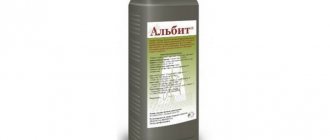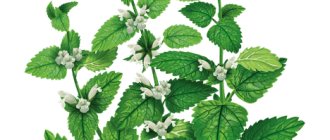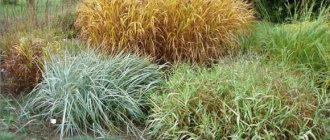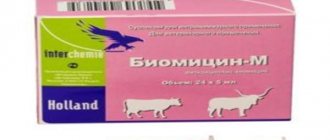What is acaricide
This is the general name for agrochemical mite control agents. Acaricidal drugs are divided into 3 groups:
- Insectoacaricides that can simultaneously kill mites and insects. These include FOS, some pyrethroids, and products containing inorganic sulfur.
- Specific acaricides act only on ticks. These include drugs with sulfur, bromine, as well as heterocycles with nitrogen.
- Acarofungicides can destroy mites and pathogenic fungi.
Acaricides are used for plants grown at agricultural enterprises, on farmers' plots and on personal farms.
History of the development of acaricides
For many years, insects were considered the main plant pests. And the harm caused by small pests - mites - was not considered as a result of their activity. The lack of knowledge of the biological characteristics of this type of insect, accordingly, could not determine effective means for their destruction. The most “ancient” methods of protection against ticks are fumigation with sulfur, the use of mineral oils, etc.
A revolutionary step in the field of protection against ticks and insects was the discovery and use of COCs (organochlorine compounds). Based on COS, the first drug DDT (dichlorodiphenyl trichloromethylmethane) was synthesized, which for a long time became one of the main drugs for protecting plants from insects. However, later the use of this drug began to be abandoned due to its extremely weak effect on ticks and the negative impact on the environment. To replace it, HCH was created (the drugs “ Lindan ”, “ Hexachloran ”), which are currently used.
Later they began to use FOS (organophosphorus compounds), which work both as insecticides and as acaricides. The very first was, and today the most famous, “ Karbofos ” (active ingredient – malathion/metathion). To this day, this drug remains one of the most popular. There is a separate article on the website “Known - unknown “Karbofos”: what you should know when using it” . Its popularity among FOS is ensured: firstly, by its broad focus of action (gnawing and sucking insects, plant mites); secondly, low cost; and thirdly, low phytotoxicity.
However, practical observations indicate resistance of ticks to drugs based on COS and FOS; new generations of ticks show high resistance.
Resistance - resistance (stability, immunity) of the body to the effects of various factors - infections, poisons, pollution, parasites, etc.
Currently, biologists and chemists from all leading countries continue to work on the search and development of new specific acaricides, as the number of ticks in the world continues to increase every year.
Classification of acaricides
The products have different active substances in their composition, and therefore have different effects on ticks. Let's consider the main classes of acaricides and typical preparations.
Insectoacaricides
They are chemical and biological. The main crops treated with insectoacaricides are grains, vegetables, melons, industrial crops, fruits and potatoes. These include the drugs “Aktara”, “Force”, “Karate Zeon”, “Vertimek”, “Enzhio” and others. Insectoacaricides do not accumulate in plant tissues, do not remain in the soil, and decompose quickly.
Pyrethroids
Pyrethroids are contained in Dalmatian chamomile flowers; their analogues are artificially reproduced synthetic pyrethroids, whose structure and mechanism of action are similar to natural ones. Preparations with pyrethroids are used to exterminate ticks on garden and horticultural crops, stock pests, ticks in the home, and they are used to treat animals against parasites. Examples of drugs: “Iskra”, “Altair”, “Alfabel”, “Alfashance”, “Tsunami”, “Fatrin”, “Pinocid”.
Sulfur-containing drugs
In addition to acaricidal, they have a fungicidal effect. Contact type drugs. Examples: colloidal sulfur, “Propargit”, “Cumulus”, “Tiovit Jet”.
Bromine preparations
This class includes products with bromopropylate (Neoron, Polisan). They are used on grapes, berries, fruit trees, and shrubs against fruit and spider mites. The products act contact, intestinal and as fumigants.
Heterocycles with nitrogen
In addition to products with bromopropylate, this class of acaricides stands out for its functionality and noticeable effectiveness. Heterocycles act on eggs; adult pests are not destroyed, but become infertile. Because of this, the growth of tick numbers slows down sharply. The heterocycles include the drugs Pyridaben, Phenazakhin and Clofentezine.
Discussion
Demodex mites
are saprophytes of human skin, but there are reasons that contribute to their transition to a pathogenic form. Thus, exposure to high temperatures, ultraviolet radiation, unfavorable living and working conditions are classified as external causes; changes in the human immune system associated with diseases of the nervous, vascular, hormonal systems, gastrointestinal tract, dysfunction of metabolic processes - internal [6]. Complication of demodicosis is the seventh most common among skin diseases and amounts to 2-5%, its frequency in patients with rosacea is 88.7%, in patients with papulopustular dermatoses - 10.5%, and with perioral dermatitis - 58.8% [7-10]. According to the literature [11, 12], demodicosis can be either an independent primary process or accompany diseases such as acneiform dermatoses, folliculitis, seborrheic dermatitis, etc.
In 2010, R. Segal et al. [13] proposed using a dermatoscope as a diagnostic tool, which allows one to see mites on the surface of the skin. Bloodless research methods also include a standardized biopsy of the skin surface with further study of the material using light or electron microscopy [14-16]. Other atraumatic research methods include the use of optical coherence tomography, which allows real-time assessment of the condition of patients’ skin in two projections, and confocal laser scanning microscopy of the superficial layers of the skin in vivo
, with which you can obtain a three-dimensional four-dimensional image [9, 13]. The advantages of the methods are non-invasiveness and patient comfort, as well as their high information content. The use of these methods makes it possible to confirm the effectiveness of treatment according to the existing diagnostic criteria, as well as to select and timely adjust medical prescriptions. Currently, therapy for demodicosis is carried out in stages, systemically, with the inclusion of anti-inflammatory, antibacterial, desensitizing and other drugs, as well as preventive measures [17].
The existing empirical ideas about the treatment of demodicosis do not fully take into account the possibility of etiological therapy with drugs with an acaricidal effect, both as a monocomponent and as part of complex therapy. This is due to the fact that in the development of this disease, not only dysfunction of histohematic barriers, but also the penetration of parasite waste products into the local blood microcirculation system can play a role. A decrease in local immunoresistance causes an increase in the number of parasites and an increase in their activity. This, in turn, can cause the accumulation of toxic substances in the microcirculation vessels of the skin, which reduces their elasticity, increases endothelial permeability and expansion of the vascular network. Local angioedema occurs, visually looking like rosacea. Since the etiology and pathogenesis of demodicosis are poorly understood, the antiparasitic effect and normalization of the regulation of the vascular component of the histohematological barrier should be taken into account as treatment approaches.
This study shows the acaricidal effect of the use of the drug D-18 and its components, as well as a comparison drug (active ingredient - ivermectin 1%) in an in vitro
on mites of the genus
Demodex
. The drug on the market containing ivermectin 1% has contraindications such as individual intolerance, pregnancy, lactation, age under 18 years, as well as a number of side effects such as burning, irritation, itching, dry skin, contact and allergic dermatitis. The drug is limited in use in patients with liver pathology.
According to preclinical studies conducted in, the experimental drug D-18 has a low degree of toxicity, which indicates its greater safety.
Method of penetration and mechanism of action
Acaricides primarily act as contact agents, but their mechanism of action differs depending on the influence of the active substance. There are also fumigants, such as magnesium phosphide or methyl bromide, which are used to treat grain mites. They emit toxic gas that paralyzes pests. Methyl bromide acts not only on ticks, but also on their eggs.
See also
Instructions for use of Diazol and insecticide composition, dosage and analoguesRead
Ticks are susceptible to toxins immediately after hatching from eggs and when they are in the stage of junior larvae. At older ages, adults also acquire some resistance, so you need to try to treat them as early as possible.
Classification of acaricidal agents
All drugs can be divided into 3 large groups:
Insectoacaricides
Universal products used at home and in agriculture against various pests. These include:
- Organophosphorus insecticides are acaricides against ticks, harmful to adults and larvae, but not dangerous to eggs. Substances accumulate in the tissues of the parasite’s nervous system and block the vital functions of all organs. Among the drugs based on FOS are Karbofos, Sumiton, Actellik. The systemic insecticide from this group, Actellik, has received many positive reviews from gardeners. The drug has a contact, intestinal and fumigant effect, destroying pests on both sides of the leaves. The product is sold in the form of an emulsion of 2 and 5 ml, 1 or 5 l.
- Avermectins are synthesized from soil fungi and have a neurotoxic effect leading to paralysis and death. These substances include Akarin, Fetiverm, Vertimek.
- Amidines are derivatives of carboxylic acids that form stable compounds. They have a contact effect and repel parasites. The compounds are used for the manufacture of acaricidal preparations for animals (collars, drops on the withers).
- Pyrethroids are high-intensity synthetic compounds that are artificial analogs of the natural compound found in Dalmatian chamomile. The substances are characterized by selective toxicity and are used to treat crops and animals against ectoparasites. Pyrethroids affect the nervous system of insects, leading to their paralysis and destruction. Among the drugs: Danitol - a contact-intestinal agent, Mavrik - an acaricide against sucking pests, Talstar insecticide.
Specific acaricides
Drugs with a narrow focus, acting exclusively on arachnids. The compositions of the products differ significantly from each other; many have the ability to destroy tick eggs. Among the drugs:
- Sulfur compounds (sulfonic acid derivatives) are contact acicides against ticks with high efficiency at each stage of development. Drugs that affect the fertility of females - Omite, Nissoran.
- Tetrazines are active compounds against all stages of development of the parasite Apollo, Flumite.
- Benzylates – preparations containing bromine, completely destroy pests and have a long-lasting protective effect. The most famous remedy is Neoron. The substance has a rapid acaricidal effect on active stages and eggs. Parasites do not develop resistance to the active substances of the drug.
Acarofungicides
Substances that destroy ticks and pathogenic fungi. A common option is sulfur in the form of granules and powder. The disadvantage of the drugs is that they are toxic to many insects.
Attention. Long-term use of one type of acaricidal agent leads to the development of resistance to its effects. It is recommended to change medications several times per season.
How long does the effect last?
If there are a lot of mites on the plants, you need to use products with pronounced initial toxicity. Use low-toxic drugs simultaneously with FOS or highly toxic acaricides (“Pyridaben”).
Expert opinion
Zarechny Maxim Valerievich
Agronomist with 12 years of experience. Our best country expert.
Ask a Question
Propargit works the longest of all drugs (up to 15-20 days). The effectiveness of some acaricides, such as bromopropylate, is fully effective even in cold weather.
Remedies against ixodid parasites
The most convenient form of acaricidal preparations for ixodid ticks are sprays and aerosols. They process clothing and camping equipment before going into the forest. For animals that are also targets for predatory arthropods, drops and collars containing a repellent are recommended.
Gardex
Aerosol acaricide Gardex is applied to clothing, backpacks, tents and other fabric surfaces. The use of 2nd generation pyrethroids makes the product effective against parasites and safe for humans. Upon contact with an acaricidal compound, after 10-15 minutes the tick loses its ability to cling and stick, and complete paralysis occurs. The effect of the product lasts on fabric for up to 15 days.
Taiga Antiklesch
Spray for protection against ixodid ticks, which carry deadly diseases. The substance is applied to clothing, curtains, and mosquito nets. It is recommended to carry out the treatment outdoors or in a well-ventilated area. One application is enough for 2 weeks or until washing. To spray clothes, 25 ml of the drug is enough. Do not use on people, the composition (neonol, alphacypermethrin) is toxic.
Attention. Repellent preparations do not kill ticks, but only repel them. Such products can be applied not only to clothing, but also to human skin. Their action is quite effective, but during the peak season the drugs will not prevent the bite of a hungry parasite.
Frequency of application
In order for acaricides to show maximum effectiveness, it is necessary to treat the plants so that the leaves and stems are completely moistened. The frequency of spraying varies, from 1 to 2-3 times. The period before harvesting the fruits also varies - from several days to 2 months, it all depends on the toxicity of the substance, dosage and consumption of the solution.
A little about ticks - their harm and benefits
In general, mites, or acarids (a subclass of arachnids - arachnids) are the most harmful group of multicellular animals in general. The harm from ticks is literally incalculable - so far neither individual specialists nor their teams (including international ones) have been able to accurately assess it on a global scale; All that is clear is that it is huge.
Certain types of harmful mites
There is no need to explain what the ixodid tick is (item 1 in the figure) and why it is dangerous. Gamasid blood-sucking mites are even more dangerous, but in Russia, fortunately, they have virtually been eliminated. However, it is too early to discount gamasoids - in the former Soviet Central Asian republics, populations of gamasoid mites are now being revived.
Note : have you heard the word – zindan? This is an old Asian underground prison, abundantly populated by gamasoid mites. Imprisonment in zindan was equivalent to a very slow and extremely painful death penalty. If the condemned person was asked as a “special favor” - to be imprisoned or impaled? – then many preferred the latter.
Spider mites (item 2) are capable of destroying both the entire crop/harvest of this year and productive perennial plantings at the root. And grain (pos. 3), flour and granary (pos. 4) mites - render food supplies completely unusable. The scourge of beekeeping is the bee mite Varroa (Varroa, item 5); poultry farming, productive and ornamental, feather-eating mites (item 6), and fur farming – lice-eaters.
The scabies mite (item 7) still remains an extremely annoying and dangerous parasite of humans; Tick-borne scabies are painful, and tick burrows are an open gate for secondary infections. The wintering grain mite (item 8), or ear mite, causes serious damage to pastures and lawns. Houseplants are sometimes attacked from nowhere by free-living phytophagous mites (pos. 9), and acarologists sometimes find it difficult to determine their species.
Finally, among the acarids there is such an “exotic” as... the wine mite (pos. 10). Some wines require ripening in open vats. This is where ticks infest them, like water striders on a pond - hereditary, but very resilient alcoholics. As a result, the entire batch goes to waste: a noble and healthy (with moderate consumption) drink acquires the “taste and bouquet” of tick-borne waste products and becomes toxic.
Note : in fig. Above and in the explanations to it, only certain types of harmful mites are given and described, but there are many more of them in total. For example, in museums and libraries, book mites and carpet beetles are considered the most dangerous pests. It’s fortunate that the ticks have not yet reached the radioactive waste storage facilities to spread them around. But, given their vitality and omnivorous nature, it is not absolutely impossible.
Unconditional harm from ticks
Harmful mites are gnawing and sucking pests, as well as carriers of diseases of humans, animals and plants, especially. viral. In crop production, the exceptionally high harmfulness of mites is explained by their high fertility and gluttony - a female mite, in order to get enough food to lay eggs, needs to consume many times or tens of times more nutrients than an insect pest of the same size and egg-laying volume. In addition, phytophagous mites release digestive juices into the plant (which is generally characteristic of arachnids), which are quite strong phytotoxins.
Ixodid ticks have “improved” the mechanism of external digestion, since they suck ready-to-eat highly nutritious blood (or hemolymph of host insects). Ixodes seem to grow into the body of the victim (or fuse with it for the period of sucking), in some way that is not yet entirely clear, modifying the living tissues surrounding the proboscis; At the same time, painkillers are released. Therefore, simply pulling out an embedded tick is dangerous - it can make things worse. Methods for safely removing Ixodid ticks from humans and pets are listed at the end.
Note : the method of “implanting” ixodid ticks into the victim’s body is being actively studied, because Some of its mechanisms could potentially be very effective in medicine. But claims that a tick bite itself is beneficial is illiterate and irresponsible chatter, if not a deliberately destructive lie.
Every family has its black sheep
This is from the point of view of a “normal” harmful mite. But in the end, it may turn out that they are the freaks, they are simply most often visible to the naked eye, and the harm from them is obvious.
The fact is that fertile soil is literally filled with small and tiny soil mites (pos. A in the figure), predatory and phytophagous. Some of them (by the way, also visible to the naked eye), such as, for example. root mite (pos. B) are harmful, but the degree of their harmfulness has not yet been definitively determined.
Soil mites
But the vast majority of soil mites are microscopic creatures. How many there are in terms of the number of species and total biomass, so far there are only guesses and rough calculations. It is possible that soil micromites, due to both factors, are no less, or even more, than insects. Of which today there are over 2 million species known (far from conclusively), and in terms of biomass - from 3 to 20 times more (also approximately) than all other animals and plants combined. The Earth is not a planet of people; The Earth is a planet of arthropods, we simply became its rulers. With all the attendant responsibility.
The world of soil mites has not been studied enough, to put it mildly. What is clear today is that most of them are not only useful, but vitally important for the formation and preservation of soil fertility. Microphytophagous mites are also useful; they control soil fungi and algae; especially blue-greens (BG), which can create serious problems in crop production and many others. other industries related to land. This leads to enormous difficulties in the creation and use of agrotechnical acaricides. Getting them into the ground destroys one of the foundations of the soil biocenosis, and as for mites - root pests, it is completely unclear: how to beat them without simultaneously killing the earth? This is one of the main reasons why there are so few acaricidal agents, and they must be used carefully, avoiding in every possible way the drug getting into the soil. An exception is root mites on indoor plants, because in this case, the root system can be bathed in acicide, and the entire contaminated substrate can be replaced with a healthy one.
Impact on the environment, people and pets
Among the popular acaricides there are many drugs that act not only on the object of their application - ticks, but also on insects - harmful and beneficial, primarily bees, as well as entomophages. You need to pay attention to this parameter when choosing a drug for processing.
Toxicity to humans and animals is expressed in irritating effects on the skin and mucous membranes, as well as toxic effects upon ingestion. The degree of toxicity is expressed in hazard classes from 1 to 4, where 1 is the greatest danger, 4 is the least. For household use, products with class 4 are produced, for treating plants in the household - 3 and 4.
Environmental Resistance
Most acaricides are destroyed fairly quickly when exposed to weather conditions. They are affected by precipitation, air temperature, and wind. For example, the hotter it is outside, the shorter the duration of the drug. That is why the products used to treat premises remain effective longer than those used to treat the area.
Treatment of the area
Instructions for the use of acaricides
The effectiveness of acaricidal drugs depends on correct use. First you need to properly prepare the solution. Plastic, glass or enamel containers are suitable for stirring; metal ones are excluded. To avoid damaging the skin of your hands, be sure to wear rubber gloves.
The preparation method for many acaricides is similar: first, dilute the required amount of the drug in a third or half of the volume of water until completely dissolved. Then add the remaining volume and stir again. Pour into the sprayer tank. The dosage, as well as consumption, are indicated for each product in the instructions, which must be strictly adhered to and not exceed the norm.
Use the prepared solution immediately and in full, store no longer than 1 day. Do not use the solution after the expiration date. Do not use expired products, the effectiveness of which is sharply reduced.
Plants should not be sprayed in sunny weather, in cloudy weather, before rain or in the morning after dew. The same goes for the wind: it is necessary to work on days when there is no wind so that the solution does not blow to the side. The average temperature at which most acaricides work well is 15-25 ˚С. If processed below this range, reduced effectiveness can be expected.
Treat plants carefully, on all sides, leaves and stems should be completely moistened. How effective the drug will be depends on the thoroughness of spraying.
Acaricides can be mixed with other agricultural products only if it is known for sure that they will not interfere with each other’s action. But, in most cases, they are used separately. When processing indoor plants, the following rules apply: remove people and animals from the premises. Wear a respirator, goggles and rubber gloves. After treatment, it is advisable to ventilate the room.
See also
Instructions for use of Bankol and insecticide composition, dosage and analoguesRead
Effective acaricidal drugs
Stores for gardeners and gardeners offer a wide range of acaricidal preparations designed to protect vegetable and grain crops and ornamental plants from ticks. All products differ in composition, principle and scope of action.
When choosing an acaricide, you need to take into account its effect on pests, the degree of toxicity, the characteristics of the plants being treated and the degree of mite infestation.
Neoron
According to the instructions, Neoron is recommended for combating spider mites and gall-forming mites on apple trees, vineyards, ornamental flowers and fruit and berry bushes. This drug is highly effective and has a long period of protective action - up to 30 days.
To prepare a working solution, 2 ml of Neoron must be diluted in 1 liter of water and used to thoroughly water the infected plant. It is necessary to process thoroughly, soaking all areas of the leaves and the surface of the soil.
Demitan
Demitan is a highly effective acaricide based on phenazakhine, which quickly destroys spider mites and gall-forming mites on apple trees, pears, grapes and garden crops.
Demitan's instructions recommend using a solution of the drug at the rate of 1200-1500 liters per 1 hectare of plantings. The product is effective against ticks at any stage of development, the protective effect lasts up to 50-60 days.
Flumite
Instructions for use Flumite allows the use of this acaricide both against adult ticks and against larvae and eggs.
To prepare the solution, you need to dilute 2 ml of the product in 5 liters of clean water. Use for spraying infected plants, trying to treat the leaf blades from all sides.
Acaricides are effective and fast-acting preparations designed to kill mites on garden, vegetable and ornamental crops. When used correctly and in compliance with personal safety precautions, such products will help protect the crop from pests and prevent their reappearance.
Is it possible to treat the area without personal protective equipment?
It is not at all worthwhile to carry out akakicidal treatment against ticks without special respiratory protection - it is dangerous, since the highest class of danger is due to inhalation (ingestion of the substance through the respiratory tract). “In terms of the degree of impact on the body of warm-blooded animals, when administered once into the stomach, the product belongs to class III moderately dangerous, when applied to the skin - to class IV low-hazard according to the GOST 12.1.007-76 classification. According to the degree of volatility of the vapor, the products belong to class III moderately hazardous according to the Selection Criteria for Insecticidal Preparations. The working aqueous emulsion (0.1%) of the product does not have skin-resorptive, local irritant or sensitizing effects. When inhaled, aerosols of 0.1% aqueous emulsion belong to class II highly dangerous, and vapors belong to class IV low-hazard according to the Classification of the degree of hazard of disinfestation agents.”
In addition, the instructions clearly state: “Persons working with the product must be provided with personal protective equipment. The personal protection kit includes: ... c) respirators to protect the respiratory system from liquid forms with a gas cartridge of brand “A” (“RU-60M”, “RPG-67″).” At the same time, getting a solution of this substance into the stomach is much less dangerous and not harmful due to the very low final concentration of cypermethrin on the treated surface.
Acaricides for plant treatment
The most popular acaricides for treating garden plots:
- Medilis Cyper is a concentrated liquid, contains 25% cypermethrin, destroys adult ticks in the treated area, can be used to treat clothing, protection time is 60-90 days; the cost of packaging 0.5 l is 1500 rubles;
Medilis Cyper anti-tick product
- Sipaz Super is a strong concentrate that kills all ticks and is effective for 1.5 months; highly toxic drug, price for 1 liter – 2250 rubles;
- Tsifox - contains 25% cypermethrin, destroys ants, cockroaches, mosquitoes, fleas and ticks, price 0.5 l - 700 rubles;
- Akaritox is a drug in the form of a suspension, the main active ingredient is alphacypermethrin, it kills parasites instantly, including those located underground; price 1700 rub.;
- Force-Site – a preparation containing organophosphorus compounds of fenthion (25%); price for 0.5 l – 1550 rub.
Review
Every year I treat the area against ticks with Medilis. There are no ticks and mosquitoes for a long time and you can be in the country without fear.
Arthur, Voronezh
The best acaricides
The acaricides listed below are most often used to treat gardens, vegetable gardens and flower crops.
- Masai acaricide is a new generation drug against mites that feed on plants. The active substance is tebufenpyrad. It is popular and effective against ticks at any mobile stage of development. May also have an effect on tick eggs. The effect lasts 10-15 days after use. Toxic to fish, bees, mammals and moderately dangerous to humans.
- Omite works well thanks to the propargite in its composition. It destroys adults, their larvae and nymphs, but not eggs, so it is usually reused. Protective effect – 21 days.
- Acaricide Apollo . The active ingredient is clofentesine. This remedy is effective against many types of spider mites and, above all, against red fruit mites. Destroys eggs and larvae, and sterilizes adult ticks. The action lasts for a month. Not dangerous to other insects, including bees. Can be used in mixture with a growth stimulator.
- Flumite . The main active ingredient is difluvidazine. The drug is hormonal and acts throughout the entire life cycle of the pest. Low toxicity, harmless to bees.
- Acaricide Neoron is a well-known drug. Reduces the population of mites and is often used on flower crops, gardens, vineyards, and fields with medicinal plants.
Acaricides are very often used to treat plants. They are effective and can literally save plants and crops from pest invasion. They can be used in indoor and outdoor areas; it is only important to choose the right type of product and use it according to the instructions.
How to use medications correctly
Processing plants in the garden
To maximize the effectiveness of acaricides, it is recommended to follow a number of rules when treating plants:
- The working solution is prepared according to the instructions included with any product and used immediately. Residues are disposed of; storage and reuse are not permitted.
- Treatment is carried out by spraying with a sprayer.
- You can spray plants only in the absence of precipitation and wind, best in the morning or evening, when sun activity is reduced.
- The use of drugs with enteric contact effects requires uniform and thorough wetting of all plants to ensure that pests enter the body.
- The most suitable temperature for processing is from 15 to 25 degrees.
- You should not mix two different drugs; many are incompatible with other chemicals and can block each other’s action.
Treatment of enclosed spaces
- Be sure to use protective equipment - rubber gloves and a respirator.
- Before treatment, it is necessary to remove all household items so as not to spray the acaricide on them. This is especially true for food products.
- Remove all people and animals from the premises first.
- Hard-to-reach places, crevices, cracks, and baseboards are treated most thoroughly.
- Immediately after treatment, you should not open or ventilate the room or do wet cleaning. You need to wait a couple of hours for the product to start working.
- After the specified time has passed, the treated room is ventilated for at least 40 minutes, after which a wet cleaning is done by adding baking soda or soda ash to the water.
An excellent assistant in the fight against aphids is the lacewing insect, which destroys entire colonies of pests. “Actellik” is an excellent product that is used to destroy pests of both garden and indoor plants. You will find detailed information about this tool here.
Wohlfarth fly larvae feed on human tissue, which in severe form can lead to serious illness and death. Read the link to find out what the dangers of meeting this fly are.











